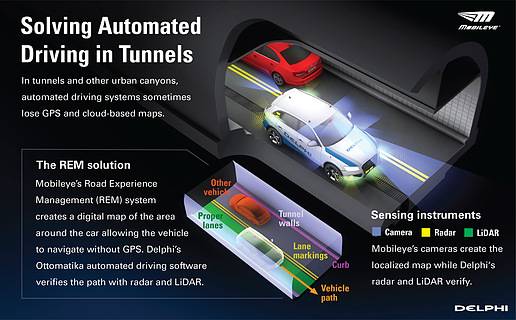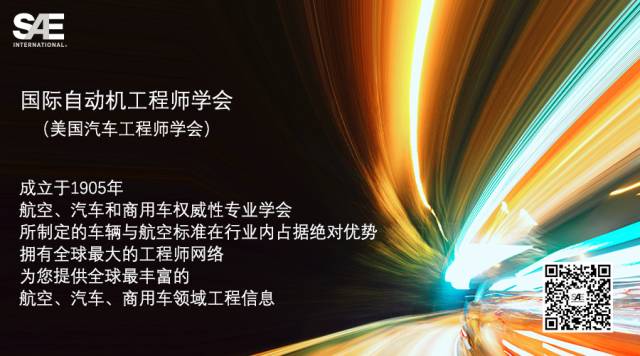 德尔福的演示车辆采用了公司的最新自动驾驶技术,目前正在美国匹兹堡市进行测试。据了解,匹兹堡也是德尔福Ottomatika驾驶软件工程部的所在地。
德尔福的演示车辆采用了公司的最新自动驾驶技术,目前正在美国匹兹堡市进行测试。据了解,匹兹堡也是德尔福Ottomatika驾驶软件工程部的所在地。 以色列机械视觉专家Mobileye公司开发的REM系统,是德尔福全新CSLP自动驾驶技术平台的关键支持技术。
以色列机械视觉专家Mobileye公司开发的REM系统,是德尔福全新CSLP自动驾驶技术平台的关键支持技术。 德尔福CSLP平台的具体硬件和软件技术简介。据称,该系统将在2019年做好上市准备。
德尔福CSLP平台的具体硬件和软件技术简介。据称,该系统将在2019年做好上市准备。 德尔福提出的高级别自动驾驶系统(SAE 4级到SAE 5级)开发规划图。这里主要指适用于量产车型的自动驾驶系统。
德尔福提出的高级别自动驾驶系统(SAE 4级到SAE 5级)开发规划图。这里主要指适用于量产车型的自动驾驶系统。
德尔福(Delphi)将在2017年美国拉斯维加斯国际消费类电子产品展览会(CES 2017)的舞台上,展示一款新型先进自动驾驶系统。作为一款“一站式”完整自动驾驶系统,该平台预计将于2019年前送达各家汽车厂商,为车辆提供SAE 4级到5级的全自动驾驶功能的支持。
据了解,这款德尔福“中央传感定位与规划系统(CSLP)”采用了英特尔(Intel)的最新超级计算机微处理器芯片,以及以色列机器视觉专家Mobileye的全新传感器融合处理器和三焦摄像头硬件系统。
提到CLSP,除了德尔福公司赋予这个系统的强大微处理能力之外,最为独特的地方也许正是由Mobileye开发的新型“道路体验管理系统(Road ExperienceManagement,REM)”。REM系统可利用众包信息为车辆提供一幅超高精度的实时地图。Mobileye称,“没有地图,就没有安全的自动驾驶系统”。
2017年CES展的技术演示道路长约10.1公里,覆盖了德尔福所称的“自动驾驶公开演示以来,最为复杂的市内/高速综合路段”。
在CES展之前举行的CLSP系统背景信息媒体发布会上,德尔福公司服务副总裁Glen De Vos积极发声称,今年的CES展将见证德尔福、Mobileye和英特尔三家公司的史上首次联合演示,我们非常激动。
“大家都希望在2019年前推出无人驾驶汽车,但在这场竞赛中,有三个因素会让真正杰出的产品脱颖而出,”De Vos表示,“一是摄像头、雷达和激光雷达等感知传感器;二是驾乘体验;三是计算处理速度。”
De Vos向在场媒体表示,相较于其他系统常用的,成本更高的激光雷达传感器,CLSP系统在生成周边环境信息时大胆采用了先进视觉感知系统与软件,因此成本相对更低。
De Vos表示,德尔福“一站式”CLSP系统的成本大约在5,000美元,而且这一数字预计还将随着元件成本的下降与销量的上升而大幅下降。他还表示,目前,德尔福系统尚未敲定任何“确定客户”。
整合各路选手与技术
在未来的自动驾驶研发中,德尔福将继续扮演自身一级技术整合商的角色,向无力或无意依靠自身力量进行自动驾驶研发的汽车厂商提供整合式系统,这也意味着在推广初期,德尔福需要承当相应的责任。
2016年8月,德尔福宣布将与Mobileye进行传感器融合方面的合作,助力高级别自动驾驶系统的发展。数月之后,公司证实已选择英特尔为系统供应计算速度高达每秒万亿次的高级处理芯片。
2015年,德尔福收购了从卡内基梅隆大学研发实验室中独立出来的自动驾驶软件工程专家公司Ottomatika。很大程度上来说,正是在Ottomatika驾驶软件算法的帮助下,德尔福才能完成2015年的那场全自动汽车横跨美国之旅。
目前,Mobileye已经与27家汽车厂商签订协议,为这些厂商提供高级驾驶员协助技术。但在与Delphi建立合作前不久,Mobileye曾直接卷入了迄今为止自动驾驶技术发展史上最大的挫折之中——一辆在自动驾驶模式下行驶的特斯拉电动车发生了事故,驾驶员不幸丧生,而这辆车正是采用了Mobileye的摄像头视觉和软件系统。
尽管如此,Mobileye的最新视觉传感硬件和软件系统仍是德尔福CLSP系统传感器融合与软件功能的核心,特别是基于EyeQ 4/5片上芯片微处理器的REM软件。这样一来,即使在没有GPS信号的情况下,车辆的摄像头视觉系统也能将车辆定位的误差控制在10厘米以内。
公司高级副总裁、首席通信官Dan Galves在谈及REM系统时表示,“这才是Mobileye对行业的真正贡献。”
REM软件目前“仍处于验证阶段,”Galves补充说,Mobileye已经开始向通用汽车(General Motors)、日产(Nissan)和大众汽车(Volkswagen)供应REM软件,支持这些公司采用的基于EyeQ芯片的视觉系统。
精度进一步提升
De Vos表示,利用REM系统实时理解“当地”环境信息是德尔福全新自动技术平台“自动驾驶系统的关键元素”。他解释说,公司最近在新加坡开展的“自动驾驶按需出行(AMOD)”试点项目,将采用基于REM的系统。德尔福还计划在北美和欧洲城市(很大可能是匹兹堡和波士顿)开展类似的AMOD演示项目。
有意思的是,在Mobileye和英特尔的协助下,尽管德尔福的CLSP平台拥有很大的计算处理容量,但REM软件本身并不需要很大的存储容量。系统仅需大约60GB的数据存储空间,就可以记录全美所有“本地化信息”所需的路测标志、建筑物,以及无数的其他固定道路标记。
但至少到目前为止,先进摄像头系统和REM仍无法取代激光雷达传感系统所提供的高精度车载地图功能。德尔福的De Vos表示,为了增强车辆的视觉传感功能,我们的CES演示车上安装了6个机电激光传感器,当然还有雷达系统。
德尔福认为,AMOD项目很有可能成为高级别(SAE 4级到5级)自动驾驶系统的首批采用者。De Vos称,自动大巴、出行“小车”和私人驾乘分享汽车可能是高级别自动驾驶在推广初期的最佳应用。
Delphi will use CES 2017 to demonstrate an advanced new automated-driving technology platform the company plans to make available to automakers by 2019 as a complete system to enable vehicles to operate with SAE Level 4-5 fully autonomous capability.
The Delphi technology platform, called Central Sensing Localization and Planning (CSLP), leverages the latest supercomputing microprocessor chip from Intel, as well as a new sensor-fusion processor and tri-focal camera hardware from Israel-based machine-vision specialist Mobileye.
But apart from the pure microprocessing power Delphi’s assembled for the CSLP system, perhaps its most unique advance is new, Mobileye-developed software called Road Experience Management. REM provides the vehicle with crowd-sourced information to create an ultra-precise, real-time map that Mobileye said “is a prerequisite for safe autonomous driving.”
The Las Vegas demonstration during CES 2017 is on a 6.3-mi (10.1-km) course comprised of public roads that Delphi claimed is “the most complex automated drive ever publicly demonstrated on an urban and highway combined route.”
At a media information background session prior to the CES unveiling of the CSLP system, Glen De Vos, vice-president of services for Delphi, enthused that the CES demonstration is “the first time we will showcase this (combined Delphi, Mobileye and Intel technology) together. We couldn’t be more excited.
“Three factors will separate the leader from the pack in the race to offer driverless vehicles by 2019,” De Vos continued in a release: “best-in-class perception sensors such as cameras, radar and LiDAR, automotive experience and computer processing speed.”
De Vos told the media the system, because of its advanced vision-sensing and software, will be less-expensive than others being developed that rely on still-costly LiDAR sensors to generate adequate data about the environment around the vehicle.
He said Delphi projects its turnkey system will cost on the order of $5,000, but that figure is of course expected to plummet as costs are reduced and sales volumes increase. He also said Delphi currently has no “committed customers” for the system.
Assembling the players and technologies
For autonomous-driving development, Delphi will continue its established role as a Tier 1 integrator of technology in order to sell a complete system to automakers, many of which either do have the resources to develop their own automated-driving system or are not inclined to do so, preferring for suppliers to make the investment—and, potentially, to shoulder the early-adoption liabilities.
In August 2016, Delphi announced its partnership with Mobileye to develop the sensor-fusion aspects required for high-level automated driving. A few months later, the company confirmed it had enlisted Intel to supply the advanced processing chipset that will enable trillions of calculations per second.
In 2015, Delphi acquired Ottomatika, an automated-driving software engineering specialist spun off from research at Carnegie Mellon University. It was Ottomatika driving-software algorithms that subsequently helped Delphi achieve a fully autonomous cross-country vehicle trip in 2015.
Not long before its partnership with Delphi, Mobileye, which has contracts with 27 automakers to supply some type of advanced driver-assistance technology, was on the front lines of autonomous driving development’s most notable setback to date: a Tesla car using Mobileye camera vision and software crashed while under autonomous control, killing the driver.
It is Mobileye’s latest vision-sensing hardware and software, however, that is at the center of the Delphi CLSP system’s sensor-fusion and software capabilities—particularly the REM software “overlay” on its EyeQ 4/5 System-on-a-Chip microprocessor. This enables the camera-vision capabilities alone to position the vehicle with a 10-cm (3.9 in) accuracy—even in the absence of a Global Positioning System (GPS) signal.
Dan Galves, senior vice-president and chief communications officer, said of REM, “This really is what Mobileye is offering to the industry.” He added that in internal development, a test vehicle was able to drive autonomously using only camera vision after just four circuits of a congested portion of I-75 near Detroit supplied the necessary visual data for REM.
The REM software is “really in the validation phase right now,” said Galves, who added that Mobileye also has supplied the REM software to EyeQ-based vision systems being used by GM, Nissan and Volkswagen.
Next-gen accuracy
Real-time understanding of the “local” environment with REM is “the key element of automated driving” using Delphi’s new autonomous-technology platform, said De Vos. He explained that the company’s recent automated mobility on demand (AMOD) pilot program in Singapore will adopt the REM-based system. Delphi also plans AMOD demonstration programs in North America and Europe (likely cities in the U.S.: Pittsburgh and Boston).
Ironically, despite the high-powered processing capacity Delphi is building into its CLSP platform with the help of Mobileye and Intel, the REM software itself does not require much memory capacity. The roadside signs, buildings and countless other fixed landmarks throughout the nation that the system employs for a large portion of its localization “knowledge” only needs about 60 GB of data storage.
But at least for now, advanced camera vision and REM isn’t replacing the highly accurate onboard mapping capability available from LiDAR sensing. Delphi’s De Vos said the CES demonstration vehicles will have six electromechanical LiDAR sensors, not to mention radar, to augment vision sensing.
Delphi sees AMOD projects as the likely first candidates for high-level (SAE Level 4-5) autonomous driving. De Vos noted that autonomous buses, mobility “pods” and individual ride-share passenger cars probably will be the best initial deployments for high-level autonomy.
Author: Bill Visnic
Source: SAE Automotive Engineering Magazine
等级
打分
- 2分
- 4分
- 6分
- 8分
- 10分
平均分
- 作者:Bill Visnic
- 行业:汽车
- 主题:零部件安全性人体工程学/人因工程学电气电子与航空电子
